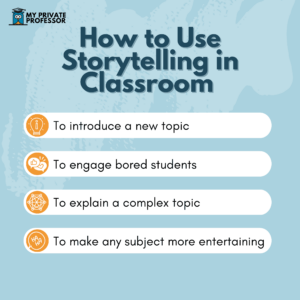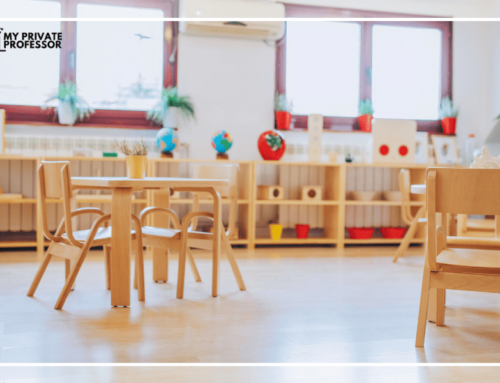One of the coolest things about humans is that every single one of us is unique. And we pride ourselves on that.
So yes, we’re unique creatures—but it’s a catch-22, because this individuality involves one universal behavior: self-expression. We all try to a) identify our voice, and b) share that voice.
For some reason, we all want our voices to be heard. We love to find ways to stand out, ways to show that individuality. And one way that we achieve this is through storytelling.
Really, we are drawn to stories—to telling them and to hearing them.
Storytelling in the classroom
If you’ve ever been, or currently are a student, you know what it’s like to sit, listening to the teacher throw out what seems like a million facts, dates, and events. And somehow, it all goes in one ear and out the other…
Often, when we don’t feel any connection to information, it can be difficult to focus on and actually retain or make meaning of it.
Stories, though, can be bridges to help us get past that hurdle.
When educators teach through storytelling, they provide context and background information. And significantly, a story offers students the chance to relate, in some way or another, to the information (and probably more than they could with just cold facts).
Stories provide context
So, for example, you could teach students that Francis Bacon was the guy who created the scientific method, which involves observation and skepticism and helps us test hypotheses.
Or, you could explain that…
In 1620, the same year the Mayflower set sail, English politician Sir Francis Bacon devised a method to help philosophers and scientists identify the level of truth to any given information. This method is now known as the scientific method. Bacon asserted that, considering how often humans incorrectly interpret their observations, it’s critical to question everything before perceiving it to be true. Bacon’s method comprised three steps: 1) describing the facts; 2) categorizing those facts; 3) rejecting that the outcome is connected with the phenomenon under examination and determining the connection.
And now, we probably feel a little more connected to the information.
When we hear stories and get to know characters, we often subconsciously (and sometimes consciously) look at bits and pieces of our own life. We relate our own experiences to those in the story. And we think about what we might have done differently than the characters in the story.
So the difference between teaching through storytelling and simply providing students with a pamphlet of information is that with storytelling, you involve and engage the students. And this, in itself, can lead to a better classroom environment and in turn, better learning outcomes.
Stories bring us together
We also use stories to connect and engage with others.
Consider the holidays. Most holidays have some sort of “meaning” and to understand and explain this meaning, we often look to stories. Stories thus help us connect with others around concepts that otherwise may be incredibly difficult to relate to.
Storytelling, then, is a gateway to creativity and critical thinking. When students tap into their creativity, they have more potential to explore new ideas and perspectives and in turn, expand their capacity for learning. And significantly, critical thinking is linked to both increased motivation and focus.
Stories yield comfort
The fact is, there seems to be one particular aspect of stories that pulls us in: they provide us with something we crave: comfort.
How? Through their structure.
That is, stories tend to have a linear perspective. Traditionally, at least, they have a beginning, a middle, and an end. We can be certain we’ll get some context, a main event, and closure.
And it’s not that we crave linearity (I don’t know many people who crave linear algebra). Rather, we crave comfort. We love comfort. And that’s why we look to comfort food at the end of a long day. Or why, when in a foreign country, we watch our favorite movie which we’ve seen countless times.
And, ultimately, it’s why we look to stories to help us through confusing, difficult, and/or unfamiliar times.
For instance, we use fairy tales to remind ourselves that we’ll get our fairy tale ending. And we hold onto myths to help ourselves believe that if we do ever find that four-leaf clover, we’ll get that deserved good fortune.
Storytelling: a medium for learning
Storytelling is an unequivocal avenue for learning. And we use this tool more often than you may realize.
For instance, parents, the ultimate teachers, use storytelling all the time. They use stories to inspire their children; to encourage them to try new things; to relate to them; and to teach them about what it means to do the right thing.
People—screenwriters, authors, motivational speakers—make careers out of storytelling. People even make careers out of reviewing stories!
Journalists use stories to enlighten the public.
Artists use songs and paintings to share pieces of themselves.
Advertisers use stories to sell their products.
Even realtors, when showing off a property, use stories to gain the attention of the client and persuade them to think more seriously about making a purchase.
And when we indulge in these stories, something cool happens. The storyteller and you—the listener/viewer/reader—will both take something different away from the stories. So you’ll both have experienced the story but will have your own, subjective experiences and perspectives.
In school, when a teacher utilizes stories, they expand the classroom’s potential for magic. That is, allowing students to draw on their subjective takeaway from a story can lead to more creativity, meaningful discussion, and innovation within the classroom.
But little do many of us realize, storytelling has a more powerful impact than its ability to spur connectivity and creativity.
Storytelling, in fact, has physiological impacts. That is, storytelling can lead both the storyteller and audience to release certain hormones. And as it turns out, the outcome can be incredibly valuable in the classroom.
Storytelling and dopamine
First off is dopamine, the feel-good hormone. A release of dopamine causes you to feel more pleasure, satisfaction, alertness, and motivation.
According to research, dopamine not only creates excitement around learning, but also helps mediate information retention and improve motivation.
So how can storytelling prompt this effect? Largely, in the way that a story can capture our attention.
That is, when we build suspense, we spur students to wonder what happens next. In addition, when listening to or reading stories in general, we tend to put some of our energy into developing our own stories in our head. We think about and predict what will happen; we hope for certain outcomes. And we consider what we’d do in that situation.
So in school, stories can be an incredibly meaningful tool to help teachers capture students’ attention and inspire them to think more actively and critically about the information presented.
Storytelling and oxytocin
Next up: oxytocin, the hormone that promotes feelings of trust, connectivity, and love.
When you think about connectedness, relationships, and meaningful interactions, what comes to mind? For me, there’s one major thing: empathy.
You’ve probably learned that empathy is a uniquely human trait, and also one of those critical skills that you’re supposed to develop in life. And it’s true. Empathy (the ability to recognize and relate to another person’s feelings) is what helps to drive trust, collaboration, innovation, and ultimately, success.
In fact, according to Forbes, emotional intelligence will remain one of the top 10 most in-demand skills for the next ten years.
When we teach through storytelling, we form more of an open channel of communication with students, which leads to an oxytocin release.
So instead of telling students, “In 1665, a deadly outbreak, called the ‘Great Plague,’ hit England and killed thousands of people,” a story might describe what led up to the plague, what happened when it hit the country, and the aftermath.
When students release this oxytocin, they’re better able to trust and bond with the storyteller and with the characters in the story. As a result, they feel more relaxed. This can help inspire more more connectivity, and even more trusting/bonding. 
To put it in a few words, stories help students trust their teacher more. Consequently, they’re more likely to listen with open ears and feel confident voicing their questions or doubts. And they feel more relaxed, which makes it much easier for them to be present.
So, through storytelling, you increase the potential for open conversation and communication, and as a result, better learning outcomes.
Storytelling and endorphins
Finally, we’ve got endorphins. People often call endorphins the body’s natural painkillers—and for good reason. When your body releases endorphins, you’re better able to relieve pain, decrease stress, and to put it simply, feel good.
Generally, your body releases endorphins during pleasurable activities and when you feel pain or stress.
But, as you might guess, given the theme of this article, storytelling also can lead to an endorphin release! Pretty cool, right?
However, it’s important to note that it’s not just any story that prompts this release. It’s something specific that the story includes. And that something is humor. It’s pretty simple. When stories make people laugh, they prompt an endorphin release.
As research shows, laughter in a social setting leads to endorphin release. And as a result, this can spur more connectedness. So no, all those people who say laughter is good for the soul aren’t just pulling your chain.
When you experience this effect (similarly to the effects of oxytocin), you feel more relaxed, creative, and focused.
For teachers, storytelling can thus be a useful tool to use when discussing uncomfortable, heavy, and/or serious topics. When students get that endorphin rush, they’re again going to be better able to engage with and focus on the information at hand.
Contrastingly, if you were to simply provide students with the bare minimum amount of information around, let’s say, the Trail of Tears, they may have a difficult time absorbing and/or retaining the information. And one reason for this is that when you give students the facts alone, there’s often not any room for humor.
But with stories, you can insert humor and in turn help students engage with the material.
Storytelling helps with memorization
As noted, students may have trouble engaging with and absorbing information that’s detached from any context.
But when students have a frame of reference to which they can associate these facts, dates, etc., they can more effectively take in and retain the information. And that’s where you see the impact of storytelling on students’ test performance or class engagement.
One of the reasons why storytelling can help students with memorization is that listening to a story spurs one’s brain waves to synchronize with the storyteller’s brain waves, research shows.
That is, if you read about someone participating in a tennis match, research has found that the areas in your brain related to physically engaging in tennis are activated.
The result then, is that you feel more of a connection to the information you’re learning about—and consequently, your brain can more effectively hold onto the information.
Essentially, it all boils down to the fact that absorbing information through stories is much easier than taking in the cold, hard facts.
Storytelling can help students and teachers form better relationships
As we know, telling stories can help students feel more relaxed and trusting of their teacher. When it comes to students’ academic performances, that connection with their students can be a game changer.
In fact a longitudinal study of 46 studies found that strong teacher-student relationships were linked to improvements in student engagement, attendance, grades, and fewer disruptive behaviors, suspensions, and lower dropout rates.
So by including stories in their instructional methods, teachers can not only enhance the classroom environment, but also improve learning and outcomes.
Storytelling is a meaningful tool for students, too!
Storytelling isn’t just a valuable tool for teachers. Students, too, can benefit from telling their own stories.
When students have the space to tell their stories, they get the opportunity to have full agency over their work—and this can take them anywhere. Providing students with a chance to tap into their creativity, learn about their hopes and dreams, and identify their passion simply helps them understand themselves a little more.
As a result, students may very well feel more confident, which inevitably carries over to their performance in the classroom. So how can teachers create this space? One surefire way is by providing time for free-writing.
Allowing students the time to engage in free-writing is a great way to empower them to tell their stories. Additionally, having time to write can allow students to let go of baggage that might be affecting their work in school.
For instance, maybe a student had a traumatic experience. And, as they write, they realize that this trauma led to them losing confidence in school. Identifying this reality can allow the student to release some of the angst they’ve been (perhaps subconsciously) holding in. Consequently, with less stress and anxiety, the student will likely feel a little more confident, and thus more engaged and present at school.
This writing period also promotes emotional resilience among students. Having time to write (with no judgment) allows students to say what they’re feeling, and what they mean—and this forces vulnerability. And evidently, vulnerability is one of the key tools necessary for building healthy relationships and developing good communication.
And at a time (the K-12 school years) when gaining a sense of identity seems absolutely paramount (yet also arbitrarily challenging), the chance to learn about oneself is incredibly meaningful.
Final thoughts
It seems that we often forget how big a role stories and storytelling play in our lives. When it comes down to it, there’s not much certainty that we can hold for the future—and admittedly, this is scary. So we use stories to help us through, distract us, or simply have a laugh.
We also use storytelling to better bond, connect, and have successful interactions with others.
Realistically, the fast-paced nature of our society can make it difficult to effectively engage in storytelling. We are motivated by productivity and efficiency—which often means doing as much as possible in the least amount of time.
Storytelling and authentic sharing take time—but considering how much of a positive tool stories can be, it seems like a pretty worthwhile investment.







